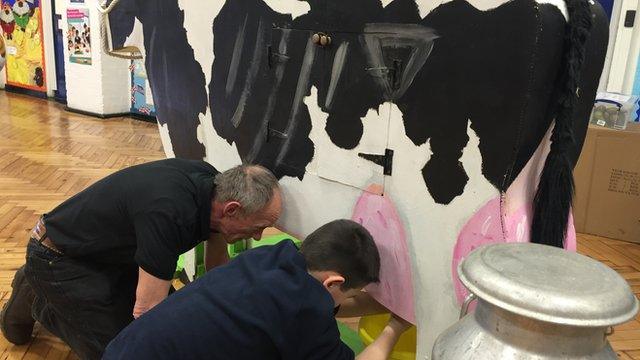Scientists say cows' milk made humans bigger
- Published
- comments

The ability to drink and digest milk is thought to have played a big part in the health and evolution of ancient humans.
A new study suggests that people in Europe started to grow bigger in size between 7000 and 4000 years ago, because they developed a tolerance to lactose during a time when people in other parts of the world stayed the same size or got smaller.
Lactose is a milk sugar, some people have problems digesting it due to the absence of the lactase enzyme, which is essential for it to break down in the body.
BBC Young Reporter: Being lactose intolerant Anisah's story
Today, people who are lactose intolerant drink and eat alternatives to milk and dairy, but for ancient humans it could've been the difference between starvation and survival.
Studies have shown that ancient humans who were able to drink milk without health complications were more likely to avoid things like famine - when there is not enough food for long periods of time.
Milk contains a type of sugar called lactose, which is different from the sugars found in fruit and other sweet foods. When we are babies, our bodies make a special enzyme called lactase that allows us to digest the lactose in our mother's milk. But after we start to eat solid food in early childhood, for many people this stops. Without lactase, we cannot properly digest the lactose in milk.
Scientists from the Western University in Ontario in Canada, examined 3507 skeletons from 366 archaeological sites in northern and Central Europe, South Asia and China dating as far back as 30,000 years ago.
They found that the average height for men and women declined from 30,000 years ago onwards, reaching its minimum between 8,000 and 6,000 years ago.
Previous research has suggested that humans became smaller when they stopped hunting in favour of growing crops.
But in central Europe, height increased between 7,000 and 4,000 years ago, while in northern Europe it increased between 8,000 and 2,000 years ago.
This week's Big Question: Who first found out that cows make milk?
Despite the earliest evidence of dairy production being found in Western Asia around 9,000 years ago, scientists says that Europeans became lactose tolerant sooner - getting more nutrition from milk helping them to grow bigger than people in other parts of the world.
It's thought that was because people from other parts of the world only ate dairy in things such as yogurt and cheese during this time - which contain less lactose than milk.

The first people to drink milk regularly were early farmers in western Europe - some of the first humans to live with animals, including cows. Today, drinking milk is common in northern Europe and North America but isn't as common, or as popular, in other parts of the world.
However, despite being early milk drinkers - and unlike other parts of Europe - the study revealed that ancient people in Britain were actually getting smaller during this time, suggesting that the milk theory might not be the only reason for a change in human sizes.
- Published21 September 2021

- Published5 October 2022

- Published11 January 2022

- Published31 March 2016

